Scilla, SquillIsqeel (Unani)Vana-Pataandu, Korikanda (Ayurveda, S. indica) Kattu Velvengayam (Siddha, S. indica) |

|

|
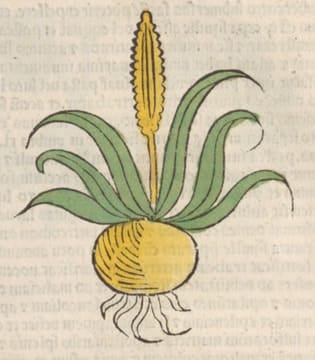 Herbarius latinus, Petri, 1485
Herbarius latinus, Petri, 1485 |
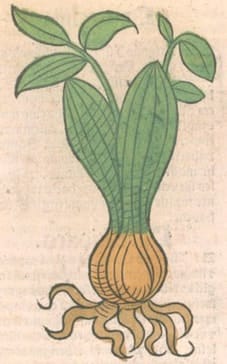 Ortus Sanitatis, Meydenbach, 1491
Ortus Sanitatis, Meydenbach, 1491 |
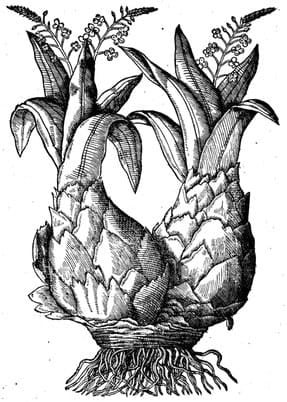 New Kreuterbuch, Matthiolus, 1563
New Kreuterbuch, Matthiolus, 1563 |
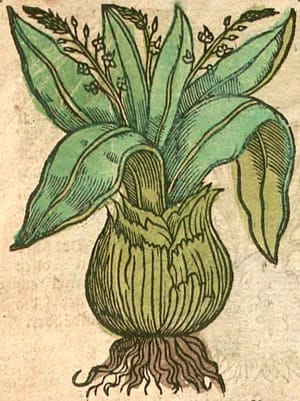 Kurtzes Handtbuchlein, Ryff, 1599
Kurtzes Handtbuchlein, Ryff, 1599 |
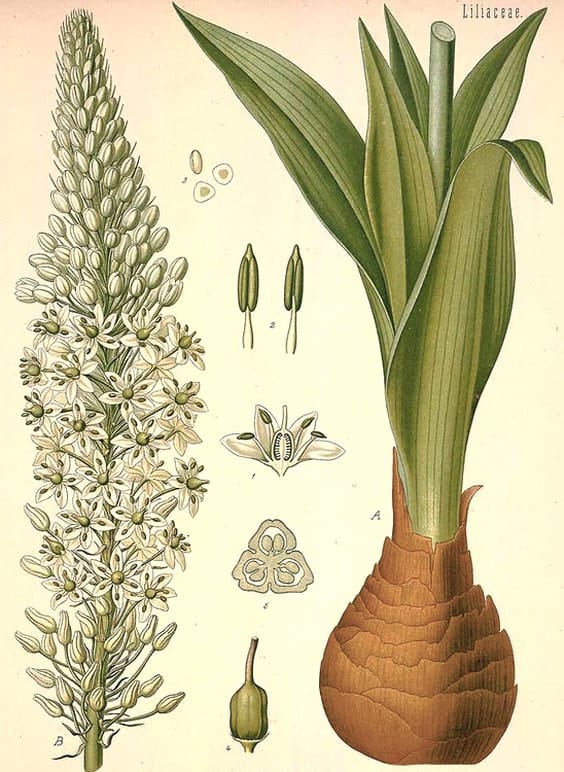 Koehler, Medizinal Pflanzen, 1890
Koehler, Medizinal Pflanzen, 1890
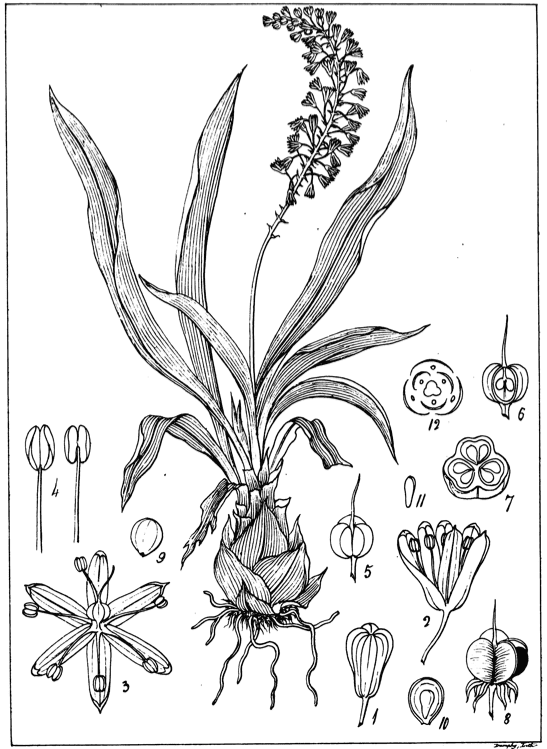
|
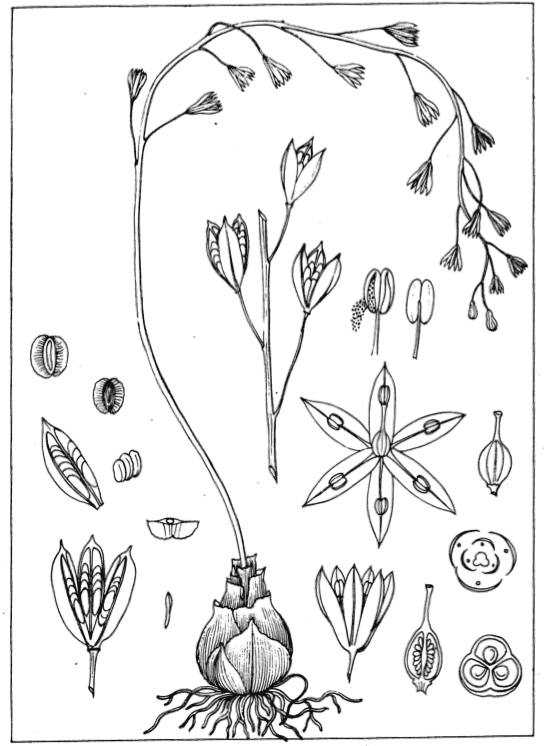
|
Figures of Indian Plants, Wight, 1853
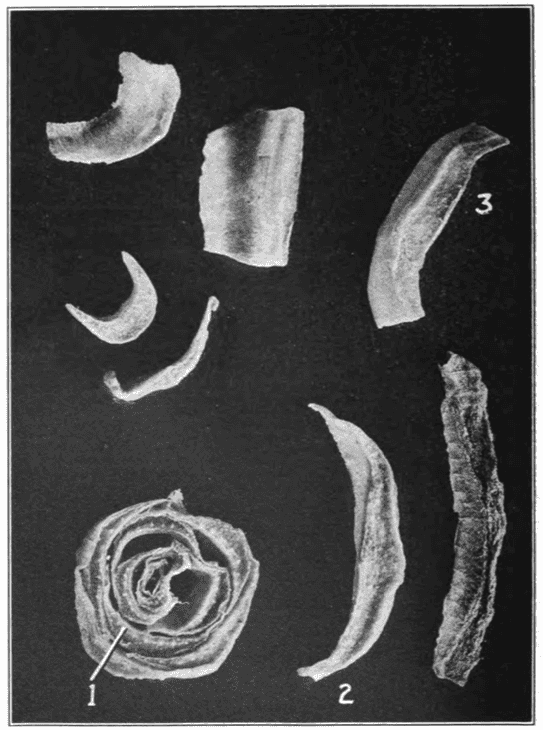 SQUILL
SQUILL1. Concentric slices of Squill bulb. 2. Typical curved
pieces. 3. Irregular pieces of the bulb.
Squibb’s Atlas of the Official Drugs, Mansfield, 1919
Botanical name:
Scilla maritima (syn. Urginea maritima, Drimia maritima)
S. indica (South Indian Squill) and Urginea indica (Red Squill) have been used similarly and as substitutes for Scilla maritima.
Parts used:
Prepared Root
Temperature & Taste:
Very Warm, dry. Pungent, Bitter, Sweet
attenuates, cuts, discusses
Classifications:
3K. EXPECTORANT
2C INCIDERS. 2D ATTENUATERS OF CONGEALED BLOOD. 2F. PURIFYING. 2L. EMOLLIENT
3A. SUDORIFICS & DIAPHORETICS. 3E. DIURETIC. 3F. LITHONTRIPTIC. 3I. APHRODISIACS. 3K. EXPECTORANT. 3L. ANTI-TUSSIVE
4d. PECTORAL. 4e. STOMACHIC. 4g. HEPATIC. 4k. ARTHRITIC
Uses:
1. Warms and Tonifies the Kidneys, Clears Cold and Damp, Promotes Urine:
-Edema of the Kidneys or Heart (ie. in chronic Heart disease)
-‘one of the most certain diuretics in Dropsical cases’ (Culpeper)
-for conditions associated with cold and dampness, or cold and weak Kidneys.
-internally and externally for cold joint pain, paralysis, cold headache etc.
-opens obstructions the Liver and Spleen, Damp-type Jaundice etc.
2. Clears Cold Phlegm, Stops Coughs:
-Cough, chronic Bronchitis, Asthma, Catarrh, Whooping Cough, and Emphysema;
-‘the Lungs or Stomach are oppressed by tough viscid Phlegm’ (Culpeper).
3. Moves the Blood, Regulates the Heart:
-slows and strengthens the Pulse. Used as a weaker substitute for Digitalis.
-promotes Menstruation
4. Resists Poison:
-traditionally used for the bites of Venomous Beasts, poisonous Insects, venomous Sea Creatures, and various other Poisons;
-‘Fortifies the body against all manner of Malign and Pestilential diseases’ (Salmon).
-used for ‘imprudent use of Opium’. (Culpeper)
-‘It is said to drive away Witchcraft and Incantations’. (Schroder)
5. Clears the Sight.
-regarded as clearing the sight (Salmon)
6. Emetic:
-Large doses are Emetic, and sometimes Purgative.
7. Kills Worms:
-‘it driveth forth Long and Round Worms if it be given with Honey and Oil’. (Gerard)
8. Externally:
-powder or roasted bulb can be applied to Corns and Warts
-good to dry Running Sores.
-Oil was applied to Chilblains
-used externally, infused in oil, for sore heads
Dose:
1–2 grains (65-130mg) was the common dose, up to 4 grains (250mg).
From 65–200mg is the standard dose (which may be used in long-term Heart treatment); 50–100mg as an expectorant; 100–300mg is diuretic; 400–600mg, and sometimes up to 800mg has been used as an Emetic or Purgative;
Maximum single dose: 500mg, maximum daily dose: 1 ½ grams
Of the TINCTURE or VINEGAR of SQUILL (1:10): ¼–2 mls (or 5–30 drops); Maximum daily dose: 5mls.
Of the FLUID EXTRACT (1:1): 1–3 drops.
Preparation:
1. One method of preparation was to wrap it in Barley dough, then to bake until the dough is dry. It was also simply buried in hot embers. Then the outer crust of dough is removed, any burnt parts rejected, then the soft Squill is beaten, and then one-third its weight of the powder of White Lupin meal (or White Dittany) is added and these are beaten together to form a paste, from which the Troches of Squills (for Theriac) can be made.
When prepared like this ‘the vehemencie of it is taken away … not being so baked or roasted it is very hurtful to the inner parts’. (Dioscorides, Galen, Salmon)
2. Otherwise, it is cut in thin slices, and dried in the Sun for 30 or 40 days, or else in a warm oven; ‘the drying of the slices was only intended to correct any ill quality which may be in them; for as much as all that is dissipated by the Sun is only a superfluous moisture’. (Charras)
Correctives:
1. Honey, Oxymel
2. Sugar Candy (Unani)
3. Licorice
Substitutes:
1. Caraway seed (Avicenna)
2. Calamus (one-third of the weight of Squill) (Avicenna)
3. Cardamon (Avicenna)
Main Combinations:
Squill was often combined with Juniper as a Diuretic.
1. Cold-Phlegm-Wind conditions: Epilepsy, Apoplexy, Migraine, Headache, Vertigo, and to cleanse the Stomach and Lungs of Phlegm, Squill with Oregano, Hyssop, Thyme, Lovage, Cardamon, Stoechas (as in Compound Oxymel of Squill)
2. Cold Phlegm of the Lungs:
i. Myrrh (1 ½ drams), Squill (½ dram), Extract of Henbane (2 scruples), Water (sufficient). Make 30 pills. Dose: 2 pills.
ii. Squill, Orris, Elecampane (1 oz. each), Benzoin (6 drams), Licorice, Aniseed, Myrrh (½ oz.), Gum Ammoniac (2 drams), Saffron (1 dram) (Dispensatorium Pharmaceuticum, 1777)
3. Asthma:
i “Take fresh extract of Squills, pour on it a like quantity of Honey, put on the fire and boil until it becometh thick. Take one spoonful of it, and administer to the patient before and after meals.”. (Syrian Book of Medicine)
ii. Juice of Squill, clarified Honey (equal parts). (Memorial Pharmaceutique, 1824)
iii. Squill powder (8 grains), Gum Ammoniac (20 grains), Syrup of Marshmallow, Oxymel of Squill (1 oz. each) (Memorial Pharmaceutique, 1824)
iv. Squill (½ oz.), Orris (2 drams), Horehound, Hyssop (1 dram each), Myrrh, Saffron (½ dram each), Honey (6 oz.). (Dispensatorium Pharmaceuticum, 1777)
4. Bronchitis:
i. Squill, Coltsfoot, Licorice
ii. Squill with Fig and Aniseed
5. To promote Urine:
i. Squill (2 grains), Juniper (18 grains). Mix for a dose. (Pharmacopoeia extemporanea, Augustin, 1822)
ii. Squill (2 grains), Cinnamon (12 grains). Powder, mix for a dose. Give twice per day.
iii. Squill with Broom and Juniper
iv. Squill with Dandelion, Licorice
v. Squill with Cinnamon, Elecampane (Saunders)
vi. Squill with Cinnamon, Angelica, Juniper
vii. Squill with Wormwood, Balm, Juniper
viii. Squill (1 part), Potassium nitrate (4 parts) (Nouveau Formulaire Medicale et Pharmaceutique, 1820)
ix. Squill (1 dram), Potassium nitrate (2 drams), Cinnamon (1 scruple). (Pharmacopoeia Herbipolitania, 1796)
x. Squill (1 part), Swallow-wort (6 parts), Potassium nitrate (8 parts) (Pharmacia Rationalis, 1806)
xi. Squill, Ginger (12 grains each), Potassium Sulphate (2 drams), form a Powder. Dose: 10–20 grains, 2–3 times daily. (Fulder)
xii. Squill, Digitalis (1 grain each), Oil of Juniper (2 drops), Licorice (1 scruple), Cinnamon (2 grains). (Niemann)
xiii. Squill (20 grains), Digitalis (18 grains), Rob of Juniper berry (sufficient). Make 10 pills, one pill every 2 hours. (Picettario Clinico, 1825)
6. To promote Urine in Heart disease, Cardiac Edema: Squill (3 parts), Digitalis powder (1 part), make pills. (Marfori-Bachem)
7. Heart disease:
i. Squill with Hawthorn and Valerian
ii. Squill, Digitalis
Major Formulas:
Troches of Squill
Lohoch Effective for Asthma (Serapion)
Electuarium Acharistum (Nicholas)
Tincture for Vertigo
Wine for Edema
Hiera Logadii
Theriac
‘Plaster of the Jew of Steten’
1. ‘Pills of Squill‘
Cold-Phlegm Cough and Asthma, and to promote Urine.
i. Squill (1 ½ oz.), Gum Ammoniac (½ oz.), Oxymel of Squill, sufficient. (Pharmacopoeia Gallica, 1818)
ii. Squill (½ dram), Gum Ammoniac (3 drams), Potassium nitrate (1 dram), Simple Syrup (sufficient to make a pills mass; make pills of 4 grains each.
iii. Squill (2 drams), Gum Ammoniac (6 drams), Orris (½ oz.),
Cautions:
1. Toxic in overdose. The Vinegar and Oxymel are the best preparations for singular use, otherwise in compounds.
2. Not used during Pregnancy
3. Not used in Heat and Inflammation, or Yin deficiency.
4. Applied topically when fresh ’causes tremendous and unbearable itching’. (Galen)
Toxicity:
1. Contains cardiac glycosides (up to 3%), including unique bufadienolides such as glucoscillaren A, proscillaridine A, scillaren A, scilliglaucoside, scilliphaeoside. Toxic effects resemble Digoxin toxicity.
2. Oral LD50 of scilliroside is 0.7 mg/kg in male rats, 0.43 mg/kg in female rats.
3. Despite its toxicity, only 2 fatalities have been reported since 1966. (PubMed)
Main Preparations used:
Prepared Root, Troches of Squill, Syrup, Wine of Squill, Vinegar of Squill, Oxymel of Squill, Honey of Squill, Compound Oxymel, Lohoch, Fecula and an Extract
1. Honey of Squill.
i. Squill (2 oz.), Water (3 lbs.). Boil a few minutes, digest for 2 days; express and add Honey (1 ½ lbs.). Clarify, boil to the consistency of a syrup. (Pharmacopoeia Gallica, 1818)
2. Wine of Squill:
i. Dried Squill (1 oz.), Malaga Wine (1 pound). Macerate 12 hours, strain, filter. (Pharmacopoeia Gallica, 1818)
ii. Squill (1 dram), Orange peel (1 oz.), White Wine (2 lbs.). Digest 24 hours, strain. (Pharmacopoeia Pauperum Hamburgensis, 1804)
iii. fresh Squill (6 drams), Cinnamon (3 drams), Wine (1 ½ lbs.). Infuse without heat for 12 hours. (Pharmacopoeia Herbipolitania, 1796)
iv. Squill (1 dram), Juniper (1 oz.), Lesser Cardamon (½ dram), White Wine (½ lb.). Digest 3 days. (Niemann)
- Extra Info
-
History
|
‘Squill is one of the most ancient of medicines. Epimenides, a Greek who lived in the 30th Olympiad, is said to have made much use of it, from which circumstance it came to be called Epimenidea. It is also mentioned by Theophrastus, and was probably well known to all the ancient Greek physicians. Pliny was not only acquainted with it, but had noticed its two varieties. |
Dioscorides describes the method of making vinegar of squills and a similar preparation, as well as compounds of squill with honey, were administered by the Arabian physicians, and still remain in use. The medical school of Salerno preferred the red variety of the drug, which on the whole is not frequently met with in mediaeval literature. (Pharmacographia, Fluckiger & Hanbury, 1879) |
